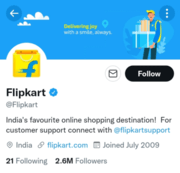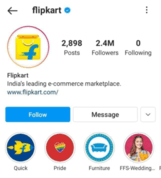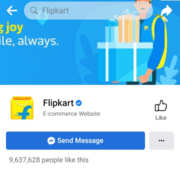Flipkart is an E-Commerce website that influences online shopping to every household beyond the world. One such e-commerce platform that is extremely successful is Flipkart. Every nation tends to go with digital with their preferences and choices, which directs to support the e-commerce industry. The business model of Flipkart performing e-commerce website on Business to Consumer. Firstly commenced as an online book store website and currently increased the market by its services to other categories as well.
In this case study, we intend to handle the Business Model of Flipkart and its marketing strategy. As you study further you will review its company, market shares, product offering, pricing model, promotional/marketing strategy, and competitor analysis of Flipkart.
First, let’s obtain a better knowledge of the company.
About Flipkart

Flipkart is India’s leading e-commerce company headquartered in Bengaluru. Sachin Bansal and Binny Bansal are the founders of India-based Flipkart in 2007. Flipkart has a wide variety of products online. In the first years, Flipkart concentrated only on selling books but currently, they are heightening their categories like home essentials, electronics, groceries, fashion, and lifestyle products. More than 1 billion people have gone shopping using Flipkart, creating the e-commerce giant one of the most famous and trending e-retailers in India. Currently, Flipkart has 100 million registered customers, 100 thousand dealers, and 21 state-of-the-art-warehouses.
Flipkart has the top score of the most visited e-commerce websites and just like Amazon, the business has promptly enhanced one of India’s innovative unicorns. Now owned by Walmart, the company is one of the great success stories of India.
Now let’s see the Business Model of Flipkart
Business Model of Flipkart
Under this section, we will cover the Market Share, Product Offering, Target Audience, Funding/Investors and the Competitor Analysis of Flipkart.
Existing India’s leading e-commerce platform, Walmart-owned Flipkart has gone toe-to-toe with Amazon. Flipkart maintained a 31.9% market share- being the largest online retailer in India according to research done by Forrester by October 2020. In the meantime, Amazon India is considerably behind in second, with a 31.2% market share. But in this last year, Flipkart witnessed an almost 50% increase in new consumers after the pandemic lockdown last year.
The platform also experienced a 35% growth in onboard dealers during 2020, compared to the previous year, according to the notice of the company this all happens due to e-commerce bursts in the country, although the majority of sales are still done offline.
Now let’s go through the product offering of Flipkart
2. Flipkart Products Offering
Next under the Business Model of Flipkart, we have its Product Offerings. Being India’s prominent e-commerce marketplace with more than 80 million products across 80+ categories. Flipkart is one of the leading e-commerce sites which are online web portals in India. The company has created a huge amount of customer satisfaction and loyalty through its services to the customers such as cash on delivery options, faster delivery choices, excessive discounts, return policies, refund policies, etc. all these circumstances have directed to the success story of Flipkart and the business is performing well in the market at present.
Consumers are capable of obtaining any kind of product easily from one portal without many searching problems; this company offers numerous products into the categories making it convenient for the customer to obtain the product they want. Shop Flipkart for the products as electronic items like mobile phones, laptops, tablets, and all accessories. Modern furniture like sofa sets, wardrobe, dining tables, and appliances that make your life convenient like washing matching, mixer grinders, and all the items.
Flipkart gets them all covered, you just need to name it and shop. These components have been directed to enhance the working of the company and the company seems forward to better and more achievement in the market.
So now that we have understood about the company, let’s now study further about Flipkart’s business model and digital marketing strategies.
3. Flipkart Target Audience
Flipkart focuses on anyone who browses the internet and who does not have time for shopping. However, its target audience is spread over a variety of market sectors as customers from all family backgrounds can discover products and Flipkart has a target audience of 75% interest of its audience between the age group of 16 – 55. Individuals are looking for online shopping from home without getting outside.
So Flipkart expands its marketing strategies where the location does not matter at all and every location in the country deliveries are done. Flipkart originates higher through following smart marketing strategies to grab the interest of its audience who influence the purchasing power, to inspire that online shopping is beneficial than traditional shopping.
4. Flipkart Funding and Investors
Flipkart has raised a whole of $12.6B in funding more than 25 rounds. Their recent funding of $3.6 Billion was raised on July 12, 2021, from a Corporate Round round led by GIC, Canada Pension Plan Investment Board, SoftBank Vision Fund 2, Walmart, and other investors.

Flipkart commenced with an initial capital of $6000 in the year 2007. Flipkart turns out to be a unicorn startup and South African Tec Major Naspers declared funding of $150 million in the year 2012. Subsequently, Flipkart obtained Myntra in the year 2014, it was capable to bring up funding of $210 million.
5. Flipkart Competitor analysis
Lastly, under the Business Model of Flipkart, we will tackle its Competitor Analysis. The competence rivals mainly with Amazon’s Indian subsidiary and the native rival snap deal. As of March 2017, Flipkart maintained a 39.5% market share of India’s e-commerce business. Flipkart is extensively dominant in the trade of apparel (a position that was bolstered by its acquisitions of Myntra and Jabong.com) and was expressed as being “neck and neck” with Amazon in the scale of electronics and mobile phones.
With this, we come to the end of the Business Model of Flipkart. In the next section below we will dive into is active and interesting marketing campaigns and strategies that keeps the company up and about with the e-commerce shopping industry.
Flipkart Digital Marketing Strategy
Flipkart’s prominent marketing strategy concentrates on every single touchpoint their consumers are now at. It functions as the majority of its cost on numerous digital channels comprising paid and organic marketing. Furthermore, because India has newly experienced the digital revolution, the attempts of Flipkart are paying off. Flipkart is regarded as one of the reliable platforms for online shopping. Moreover, we discuss some gadgets or apparel, and Flipkart has constantly revealed their high-quality service. Flipkart also spends strongly on celebrity endorsement and influencer marketing.
India is passionate about Bollywood and Flipkart operates this to uplift awareness concerning their brand and to market their services. Ranbir Kapoor, Alia Bhatt, Varun Dhawan, and Shraddha Kapoor have all remained as brand ambassadors who were essentially highlighted in Flipkart’s commercials and digital marketing campaigns.
Flipkart has predominantly expanded its business through digital marketing strategy. Let’s consider, What strategy do they go along with? In what way do they change their one-time consumers to loyal consumers? In what manner does Flipkart be able to improve the number of its consumers? This piece of writing will help out in the analysis of the tools sourced by Flipkart in their Digital Marketing Strategy.
1. Collaboration and celebrity marketing
Flipkart is well-known for its collaborations. It furthermore empowers heavily in star power and celebrity marketing. Flipkart maintains collaborating with many famous figures from time to time. The most remarkable collaboration “IndiaKaFashionCapital” is done with Alia Bhatt and Ranbir Kapoor. Under this campaign, the company encourages fashion enthusiasts from the entire country to advance their style with the newest trends from Flipkart.
Through the procedure of a meaningful media mix, via a styled fashion quotient and targeted communication concerning their consumers, Flipkart Fashion’s brand ambassadors, Alia and Ranbir, update the public regarding constantly being ahead in their style game by ‘Wearing The Next.’ The pair were seen in a diversity of engaging and interactive formats, ranging from short digital content to traditional TVCs talking about the advantages of shopping on Flipkart Fashion.
2. Flipkart’s Social Media Strategy
Flipkart is extremely much more active on all social media platforms. As of August 2020, Flipkart has,
- 2.4 Million followers on Twitter.

- 1.7 Million followers on Instagram

- 93,96,244 followers on Facebook

– Flipkart’s Youtube marketing
As presently as it comes to Instagram, Flipkart has several accounts for many things, like a suitable account given to Tech, Clothing, and others. Once it reaches businesses, be it for a product or different services, the key highlight point for the customers is Feedback and Customer Reviews. Flipkart has certain special attention to that by having a separate account which just directs on Customer Story named as FlipkartStories.
With YouTube being achieved as the world’s second-largest search engine (behind Google) Flipkart entirely leveraged this platform to promote its marketing campaigns. Flipkart initiated a targeted marketing campaign for the fashion segment known as “India ka Fashion Capital”, aimed at featuring video ads on youtube as the majority of their audience are present here. Google was also capable to estimate the effect of traditional media vs digital policies, which caused clear that the brand had an existing all on digital platforms.
– Flipkart’s Twitter Strategy Campaign
You’ll be shocked to realize that out of all the platforms Flipkart assigns special attention to Twitter. Flipkart is well-known to follow a fixed pattern for communication for all the platforms but once it comes to Twitter, they maintain running mini-campaigns from time to time like #SareeTwitter. Apart from fun campaigns, Flipkart has 24*7 accessible Customer Support System on Twitter where they address complaints and queries of their consumers. Subsequently, if you face a problem with Flipkart, you know what to do.
– Flipkart’s Remarketing
Remarketing is any marketing and advertising strategy that re-establishes links with potential purchasers after they visit the store’s website. Remarketing survived before the arrival of the Internet, yet its procedure has moved from offline to online and it is extremely beneficial and inbound. Generally, visitors visit the online portals and leave the site without finalizing the purchase. Remarketing is performed by showing ads to such potential consumers across the digital platforms advising them to convert.
– Flipkart’s Kidults
As expressed earlier, Flipkart’s marketing campaign is incomplete without kids, this is done on YouTube ads or social media ads. This campaign was a blast and has been managed considerably until late 2019.
This concludes the case study on the Business Model of Flipkart, now let’s go through the final points of Flipkart.
Conclusion
Being India’s largest e-commerce platform it operates on a B2C business model by providing services related to the online book store and some other products. After it expanded into other sectors and became an e-commerce company, Flipkart shifted to a business-to-consumer model. Flipkart’s business model joins dealers and purchasers on its platform. At present, it advertises entirety from furniture, groceries, books and electronics and more items. Flipkart has succeeded to increase to the highest spots in the e-commerce industry in India despite standing in competition with alike well-known firms such as Amazon.
The Business Model of Flipkart improved the business in its development and progress. Flipkart remains the giant in the market by using the marketing strategy therefore the Flipkart has been generating profits in recent years especially due to its investments in technology. Flipkart’s company uses marketing and innovations like tv commercials or digital ads to heighten its success.
Have you enjoyed this case study on the Business Model of Flipkart? Would you like to find out more? Our Free Masterclass on digital marketing is a wonderful place to start if you’re new to digital markets. Read more case studies like this on our other blogs as well. Do inform us in the comment box below of what you think of this situation Thank you for taking the valuable time to read this blog. Share it with your friends if you enjoy it.


0 Comments